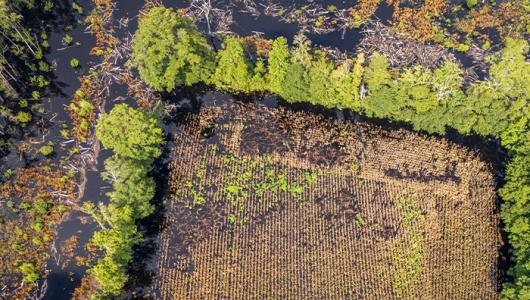Drought events are often wide-spread, persistent, and long lasting. Drought losses are as substantial as those from hurricanes, tornadoes, and other immediate-impact disaster events. Drought causes losses to agriculture, and affects domestic water supply, energy production, public health, wildlife, and contributes to wildfire.
If drought has impacted your operation, USDA can help you recover from your losses, mitigate risk, and prepare for future natural disasters. USDA offers a suite of programs that help with recovery as well as those that can help you manage risk and build resilience on your operation.
Assistance for Farmers

If you raise livestock, assistance is available through:
- Livestock Indemnity Program (LIP), for death or injury of livestock because of extreme heat or wildfires.
- Livestock Forage Disaster Program (LFP), for grazing losses.
- Emergency Assistance for Livestock, Honeybees and Farm-raised Fish Program (ELAP), for feed losses and transportation costs for feed and water.
- Emergency haying and grazing of land enrolled in Conservation Reserve Program, to help in a time of forage shortage (except during the primary nesting season of grassland birds).
We can also help with damage to conservation practices or forests. The Emergency Conservation Program (ECP) and Emergency Forest Restoration Program (EFRP) provide financial and technical assistance to restore conservation practices like fencing, damaged farmland, or forests. ECP can also help implement water conservation practices during severe drought.
Similarly, the Environmental Quality Incentives Program (EQIP) provides financial and technical assistance to implement conservation practices. Common drought recovery forest management plans, tree/shrub establishment, brush management, prescribed grazing, pasture and hay planting, wildlife habitat, livestock watering systems, and cover crops.
Finally, the Tree Assistance Program (TAP) provides cost share assistance to rehabilitate or replant orchards and vineyards (trees, vines, or bushes).
Disaster assistance programs are designed to complement risk management tools available to producers, such as federal crop insurance and the Noninsured Crop Disaster Assistance Program (NAP). Crop insurance provides indemnity payments to growers who purchase crop insurance for production and quality losses related to drought and other weather hazards, including losses caused by inability to plant on time. Meanwhile, NAP covers losses for crops not covered by crop insurance.
Producers impacted by drought should also consider available guaranteed and direct (including emergency) farm loan options. In addition to loan making, USDA offers loan servicing options for borrowers who are unable to make scheduled payments on their USDA farm loan debt because of reasons beyond their control.
Reporting Losses
If your operation was impacted by a natural disaster, you should report losses and damages and file an application with the Farm Service Agency, or if you have crop insurance, report to your agent.
Timelines for reporting losses and applying for payments differ by program:
- ELAP: 30 days for livestock and fish and within 15 days for honeybees;
- TAP: within 90 days;
- NAP: within 15 days, except for hand-harvested crops, which is within 72 hours; and
- Crop insurance: within 72 hours of discovering damage and follow up in writing within 15 days.

Improve Drought Resiliency
Conservation practices can help you use water more efficiently and boost soil health. Healthy soil stores water better for when it’s needed most. The Natural Resources Conservation Service, through programs like the Environmental Quality Incentives Program (EQIP), provides technical and financial assistance for conservation practices like irrigation efficiency, prescribed grazing, reduced- or no-till, cover crops, mulching, and residue management. Conservation practices that boost organic matter in the soil lead to more water – every 1% increase in organic matter results in as much as 25,000 gallons of soil water per acre.

More Information
To learn more, visit our Drought webpage, Disaster Assistance Discovery Tool, or Disaster Assistance-at-a-Glance fact sheet. If you want to learn more about the U.S. Drought Monitor, which is a trigger for many of our programs, read our question and answer with one of the drought monitor’s climatologists.
For assistance with USDA programs, reach out your local Service Center.
Ciji Taylor is a USDA public affairs specialist


